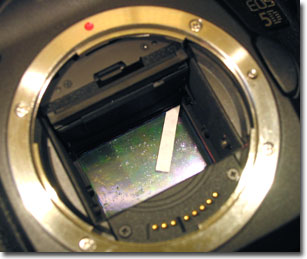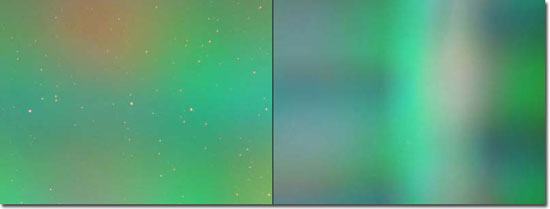How to use Sensor-Film
 Occasionally it is necessary to clean the sensor of a DSLR camera. Due to its open design, dust can enter the mirror box and settle on the sensor during exposures. All cameras have an operating mode for "sensor cleaning". On activation the mirror flips away, the shutter opens, and the sensor is exposed. What you can see now is actually not the sensor, but the infrared blocking filter which is mounted a few millimeters in front of the sensor. So you will clean just a piece of coated glass and not the real semiconductor.
Occasionally it is necessary to clean the sensor of a DSLR camera. Due to its open design, dust can enter the mirror box and settle on the sensor during exposures. All cameras have an operating mode for "sensor cleaning". On activation the mirror flips away, the shutter opens, and the sensor is exposed. What you can see now is actually not the sensor, but the infrared blocking filter which is mounted a few millimeters in front of the sensor. So you will clean just a piece of coated glass and not the real semiconductor.
 Sensor-Film is applied onto the filter with a small brush. This procedure is unproblematic since the brush does not get in contact with the glass – there is always a thin layer of viscous Sensor-Film between the hairs of the brush and the surface. Care must be taken that no liquid enters the small gap between the glass and the covering framework at the sides. The consequences are not very severe but it could complicate the removal of the dried film. It is recommended to keep a small gap to the edge of the filter. This will not degrade the result of the cleaning procedure since the light sensitive area of the sensor is a bit smaller than the filter.
Sensor-Film is applied onto the filter with a small brush. This procedure is unproblematic since the brush does not get in contact with the glass – there is always a thin layer of viscous Sensor-Film between the hairs of the brush and the surface. Care must be taken that no liquid enters the small gap between the glass and the covering framework at the sides. The consequences are not very severe but it could complicate the removal of the dried film. It is recommended to keep a small gap to the edge of the filter. This will not degrade the result of the cleaning procedure since the light sensitive area of the sensor is a bit smaller than the filter.
Depending on the temperature, humidity, and ventilation, the film will need between 30 minutes and 3 hours to dry completely. All dust particles and water soluble substances on your sensor are embedded or absorbed by Sensor-Film and ready for removal.
A fully charged camera battery can keep the shutter open for four hours or even longer. Especially for first time users of Sensor-Film it is recommended to leave the shutter open during the whole drying process. If you are traveling or have to save battery power for any other reason, you can deactivate the sensor cleaning function of your camera during drying. The shutter will close and the mirror will swing back into its rest position in front of the sensor. Of course this will lead to extended drying times. Independent of your choice, do not attach any lens to your camera because this slows down drying of the Sensor-Film dramatically. Covering the opening with a lint-free sheet of paper is absolutely sufficient to prevent dust from entering the mirror box. Make sure your camera is orientated horizontally for as long as the film is still wet. After Sensor-Film has dried it is the best moment for blowing out your camera - the sensor is protected by Sensor-Film, the mirror protects the focusing screen and the shutter blades are safely retracted. Just be careful with the auto focus optics in the base plate.
 A peel-off strap has to be integrated into the Sensor-Film to remove the dry film. Take the piece of paper you got with your Sensor-Film bottle and cut out a strap. The optimal length is a bit longer than the short side of your sensor. Now take one end and fold a triangle. In other words you need a dog-ear. Try to make the edge as sharp as you can. On the other side cut two slits into the strap to produce a predetermined breaking point. Paint the dog-ear with Sensor-Film and put a small drop on the opposite side. The area for painting is marked pink in the picture.
A peel-off strap has to be integrated into the Sensor-Film to remove the dry film. Take the piece of paper you got with your Sensor-Film bottle and cut out a strap. The optimal length is a bit longer than the short side of your sensor. Now take one end and fold a triangle. In other words you need a dog-ear. Try to make the edge as sharp as you can. On the other side cut two slits into the strap to produce a predetermined breaking point. Paint the dog-ear with Sensor-Film and put a small drop on the opposite side. The area for painting is marked pink in the picture.
 Position the paper strap in one of the edges of your sensor with a pair of tweezers. The end of the paper strap will stick out a bit. Wait one or two minutes and the strap is sufficiently glued to the film that you can bend the end down and glue it to the surface. Now the paper lays flat on the surface and in a case of battery failure the shutter will not be damaged when it closes.
Position the paper strap in one of the edges of your sensor with a pair of tweezers. The end of the paper strap will stick out a bit. Wait one or two minutes and the strap is sufficiently glued to the film that you can bend the end down and glue it to the surface. Now the paper lays flat on the surface and in a case of battery failure the shutter will not be damaged when it closes.
The paper strap and Sensor-Film have to dry again. It will take about 30 minutes. Take a pair of tweezers; grab the paper strap and rip the breaking point you produced before. Now you have a peel off strap of ideal length to pull on. The film will come off in one piece and will not leave any residues.

This is what a sensor looks like under the microscope: dusty before - and clean after treatment with Sensor-Film.
You should become familiar with the procedure before starting to clean your camera with Sensor-Film. Take a photo filter or a CD for testing and be amazed how well it works. Watch the video for further instructions and read the FAQ.
If you have not installed flash and can not see the above video you can download the movie here. The video codec is Xvid and the movie has a file size of about 8,5MB.